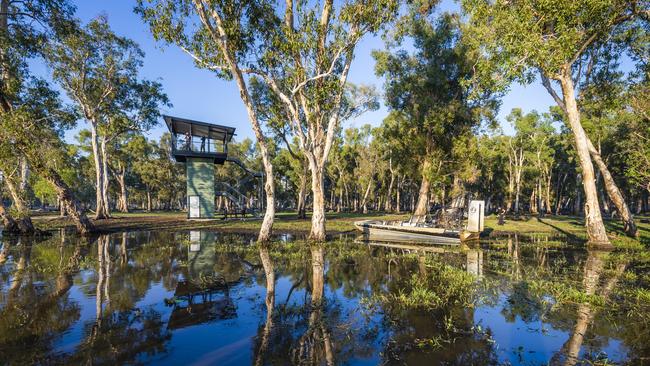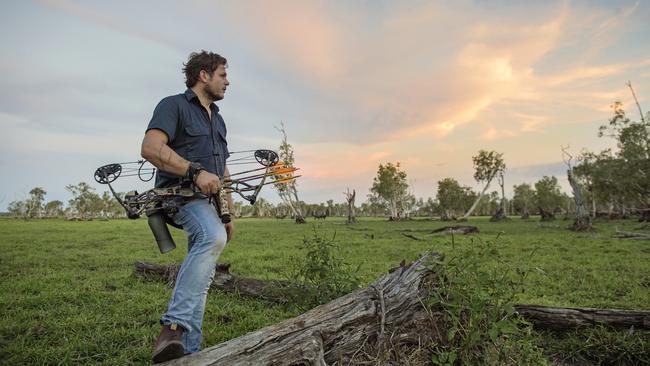Bush to banquet: Biota chef James Viles at Bamurru Plains lodge
Chef James Viles, on gourmet safari in the Top End, marvels at ways to cook catfish, wallaby and boar.

Welcome to Bamurru Plains, a luxury bush lodge on a 31,160ha property on the Mary River, adjacent to Kakadu National Park and right at the tip of the Top End of Australia. Crocodile country.
This is an unlikely location for a guest chef from the southern highlands of NSW, perhaps. Unless that chef is James Viles, whose naturalist’s approach to the menu at his Hot 50 restaurant Biota Dining has made it a destination and spawned countless imitators across the country.
It is Viles’s love for growing, foraging or hunting the flora and fauna all around him that has brought him here: to do the same in a rather different environment for a series of three-day food safaris, conceived on ethical and sustainable grounds and launching at Bamurru next week.
The journey, says Viles, has been profound. It’s a long way from picking nasturtium petals in Bowral to bow-hunting wild boar and going night-fishing for catfish in croc-infested waters in the deep Northern Territory.
“It’s another world. This is the real Australia,” he says. You can hear the awe in his voice.
“I don’t mean to dismiss my own part of the country,” he says. “But there are a lot of introduced plant species in the southern highlands. Here, it’s so raw and untouched.”
Part of Viles’s work in the run-up to the safari has entailed cataloguing native plant and animal species as part of a conservation project he is developing with Wild Bush Luxury founder Charles Carlow, owner of Bamurru Plains.
“At one point there was absolutely nobody around for miles and miles, just me and the water buffaloes,” says Viles. “Now that is a detox from modern life.”

The produce. When Viles writes “wild” on his safari menus, you can be sure he’s not being loose with the truth. Apart from crocodile meat — as a protected species, crocodiles for consumption must be farmed — the rest is the result of the chef’s hunting, shooting, fishing and foraging expeditions on the vast property, made accessible via Cessna and helicopter.
He went bow-hunting through tea-tree forest for young wild boar. He fished for catfish “half the size of me”, pulling them in every 30 seconds while keeping a watchful eye on all the pairs of crocodile eyes looking back at him. He caught barramundi — both saltwater and freshwater — hermit crabs and redclaw yabbies. He ate native orchids and waterlilies (“they’re very floral”) and used the waterlily stems as drinking straws.
And then came the fun job of converting all that wildlife into a high-end dinner. (A few dinners, to be precise, but Viles is keen to emphasise that in the interests of conservation he sourced only what was needed.) The wild boar was salted. The catfish was treated in a similar manner to jarred tuna, cooked and stored under olive oil with native spices of pepperleaf and tea-tree.
“What I want to know is, why is no one eating catfish in Australia, when they go nuts for it in southern America?” Viles asks.
Maybe we’ll catch on, if he can keep writing dish names such as this one: “Catfish caught under moonlight with waterlilies”.
Also planned for the safari menu: redclaw yabbies on toast; lightly pickled native orchids; mud crab from the Mary River with creamed eggs.
Viles’s food safari at Bamurru will not be a one-off; rather, the chef is planning to reprise the event three or four times a year. Trading places, and concepts. Paddock to plate? Try bush to banquet, for a change.
The recipe: Wallaby jerky. This is inspired by the abundance of small wallabies at Bamurru Plains. Every morning and every afternoon there would be masses of them eating the native plants in front of us.
1kg wallaby fillet or saddle (available at specialty butchers; otherwise, use kangaroo hock) | Brown sugar x 200g | Sea salt x 500g | 6 eucalypt leaves, crushed | Seasoning | 40g native pepper | 20g acacia seed | 20ml nut oil (I used macadamia oil)
Make a cure by mixing the salt, sugar and eucalypt leaves together. Add the whole fillet or saddle to the salt mix and rub well. Leave on the cure for 12 hours and then remove from the cure, wipe off all excess salt, mix with a damp towel. Slice the wallaby about 0.5mm thick into long slices with a sharp knife and then place on to dehydrator sheets (home dehydrating kits are available at retail stores such as Harvey Norman). Brush lightly with nut oil and dehydrate on 68C for four hours (alternatively, cook in oven at 50-60C for about six hours). Once dry, remove from dehydrator and season with native pepper and acacia.
Wild Tastes of the Top End food safari, May 31-June 2. Bookings and more information, bamurruplains.com.
Native ingredients are available from Outback Pride, outback-pride.com.au.
James Viles will also be cooking at the Winter Masterclass at Lake House, Daylesford, Victoria, on Sunday June 19. Lakehouse.com.au.
